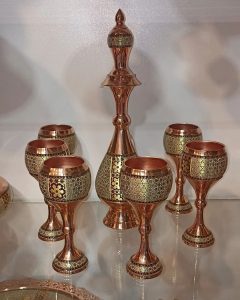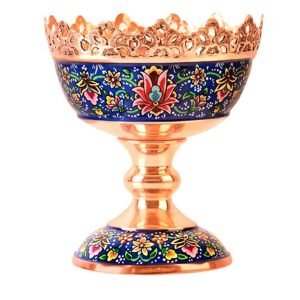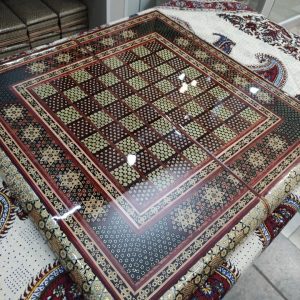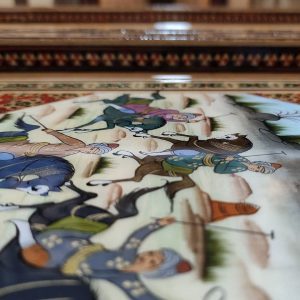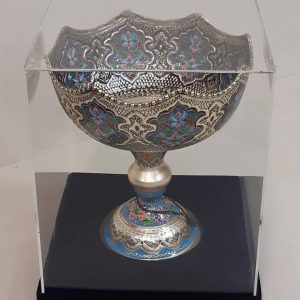inlaid work Iranian price
The definition of inlaid work Iranian price in the Persian encyclopedia is “the art of decorating the surface of objects in a mosaic-like manner, with small triangles. The various designs of Khatam have always been in the form of regular geometric shapes. These geometric shapes are patterned by placing small triangles together. Triangles are made from various types of wood, metal and bone. The smaller and more delicate the triangles are, the better the inlay is. In an inlay design, at least three triangles are used to make the smallest geometric unit and for the largest one, a maximum of four hundred triangles are used Wholesale of Iranian handicrafts

This art has reached Iran in the present way before the Safavid period and during the conquest of Iran by the Mughal Ilkhan and following the emergence of a direct relationship between Iran and China. Some other researchers also believe that Khatam Kari was founded in Shiraz during the Dilaman period in Iran and reached its peak of prosperity in the Safavid era, because on the one hand, the government supported the artists and on the other hand, it established business relations with far and near countries. The spread of Khatam art helped. In Iran, before the advent of Islam, a type of inlaying was popular, and its method of working was that they cut cubes of four millimeters from solid wood and installed and nailed them with various designs on a board, and this method lasted for several centuries. It was also common after Islam. Currently, there is a pulpit inlaid with this method in the Jame Agiq Mosque of Shiraz, which has been built for more than a thousand years Wholesale sale of Iranian backgammon
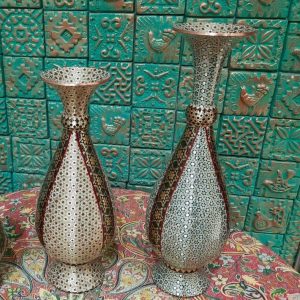
Necessary tools for finishing work
Work tools
metal clip, sharp file , hammer, pliers, wire saw, triangular saw, cave, metal meter, fixed ruler and arrowed ruler, gunya and pargar
This art has two stages
Handicrafts, which includes operations such as design of Khatam, preparation of materials and materials, and cutting of primary materials, mixing and creating flowers, and finally making Qamah (rectangular cube body with an average length of 40 cm and width of 10 cm) meters and 3 cm diameter of wood or Khatam) and cutting it and preparing the Khatam layer
Khatam work, which includes the design of the foundation, the design of gluing the layers of Khatam on the sub-work, polishing and polishing of the inlay objects fhciran shop carpets
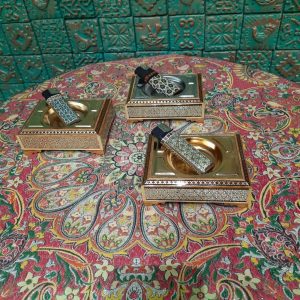
The method of making inlaid work Iranian price inlay work, wood, bone or metal are cut in the form of al-Qaeda triangle prisms and they are placed together in such a way that the cross section of these single triangles has regular geometric shapes, then thin slices are made with a tip in an orderly manner. They stick a special arrangement on a thin wooden sheet and after drying, they install the sheets on the objects needed for decoration
Types of wood are among the most important materials for inlaying, which include jujube , orange, maple, walnut, kikem, tabrizi, shamrock, ebony, betel and betel wood. All kinds of bones are also used in making Khatam due to their strength and white color, which include camel, horse, cow bones, as well as natural elephant ivory and artificial ivory. In order to make the seal durable and take care of it, colored metals are used in the seal, silver and aluminum are used for white color and brass for yellow color
In order to prepare the required wood, it should be ensured that it has the right color and texture and does not have knots or cracks. Metals must also have a suitable alloy
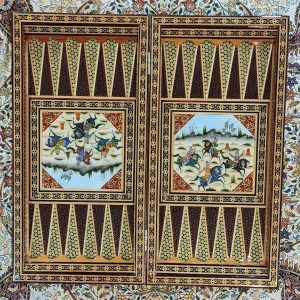
Seal lubrication
Basically, the surface of a seal is oiled for two reasons: the shine of the seal and its protection against moisture, heat and cold. In the past, polishing oil or inlaid work Iranian price(pine tree sap) was used for this. Later, Havilox oil was used, and today they use polyester
inlaid work Iranian price production steps
First, they prepare all kinds of wood and bones in different colors and cut them with their special tools to a length of 30 cm and a diameter of 1 to 2.5 mm, and triangles are made from them, and after filing all the sides, they are cut to the desired shape and according to the design. came in and to complete the design, wire wires in the form of triangles were needed, and various steps were taken to prepare them. Then, to make the seal, first the design of the desired shape was drawn by the master craftsman, and these triangles were made of wood, bone and The metal pieces are put together by the artist’s skillful and masterful hands and glued together with a thread, and they are tightened with a thread, which makes the so-called “blade”, after a few hours, the threads are opened and the sides of the file design and put four of the made blades together and glue them together again, which results in “inlaid work Iranian price”.The next stage, which is known as “Gol Pichi”, is made by means of a round wire that is prepared in a regular hexagonal shape, and it is called “Shamse”, six wires are attached around each side by a thread and tied with a strong thread. and the result is a star design, these designs are repeated until they are based on the required design and then placed under pressure and with several stages of cutting and gluing very thin layers of wood around that design First, a seal is created, and all these steps from the beginning until now include more than 400 work steps
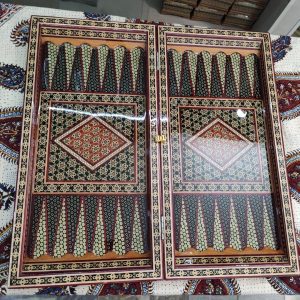
Features of a good seal
Characteristics of a high-quality inlay
the work surface is smooth and there is no empty place in the inlay
The uniformity of the color and materials used in the construction of Khatam
no change in the color and shape of the
restoration works and putty works should not be evident on the work surface
All the flowers and shapes on the work surface and the angles and sides
are accurate and the engineering of the basis and structure of the design is that all the dimensions are identical, similar and the same size. It doesn’t exist and it destroys the whole design, that’s why an inlay artist must also be a master carpenter
The painting and coating of the product must be skillful and without any defects
The smaller the patterns and triangles are, the higher the quality and value of the work
